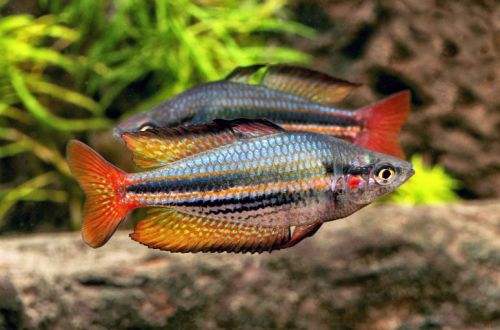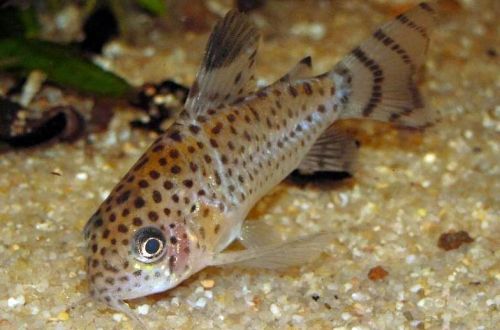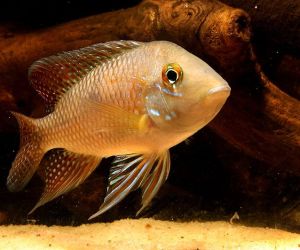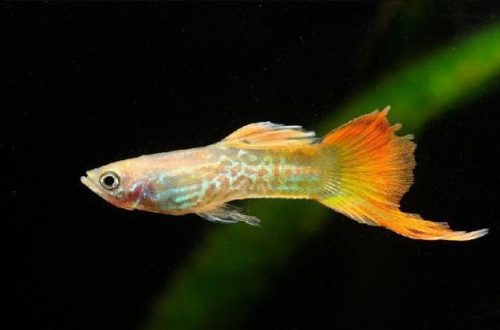
Rainbow South
Melanothenia South or Rainbow South, the scientific name Melanotaenia australis, belongs to the Melanotaeniidae family. It is unpretentious, easy to keep and breed, compatible with many other fish species, and also has a beautiful body color. All this makes it a good choice for the beginner aquarist.

Contents
Habitat
It comes from the Australian continent (Eastern and North-Eastern part) from a relatively small coastal strip bordering the mainland, where tropical rainforests are still preserved. It lives in various biotopes: swamps, lagoons, lakes and rivers. Prefers regions with a slow current and dense aquatic vegetation. Keeps close to the coast among the flooded snags.
Brief information:
- The volume of the aquarium – from 100 liters.
- Temperature – 22-27°C
- Value pH — 6.5–8.0
- Water hardness – soft to hard (5-20 dGH)
- Substrate type – any
- Lighting – subdued
- Brackish water – no
- Water Movement – Low/Moderate
- The size of the fish is up to 12 cm.
- Food – any food
- Temperament – peaceful active
- Keeping a flock of at least 6-8 individuals
Description
Adults reach a length of about 12 cm. The color is variegated, the body is decorated with several horizontal stripes of different colors (black, blue, orange), the back is bluish. The fins and tail have more red hues. The heyday may differ depending on the region of origin. Sexual dimorphism is weakly expressed, males are somewhat larger and brighter than females.
Food
Fish are unpretentious in terms of diet and nutritional composition. Accepts most types of popular foods (dry, frozen, live). It is advisable to combine different products. For example, flakes and granules should be served with bloodworms or brine shrimp. This diet will allow the fish to show their best colors.
Maintenance and care, decoration of the aquarium
The size of the aquarium for a small group of fish should start from 110 liters. The design should provide for areas with dense vegetation (rooting and floating) and free places for swimming. The presence of shelters in the form of snags is welcome. Any substrate is selected based on the needs of plants and the preferences of the aquarist.
The Southern Rainbow prefers a subdued level of lighting, weak to moderate water movement. Equipment is selected and installed in accordance with these needs. Water quality is also of no small importance (and maybe decisive). Acquisition of a productive filtration system and weekly replacement of part of the water (15–20% of the volume) with fresh water, which will maintain acceptable living conditions for these tropical fish and minimize the risk of organic waste accumulation.
Behavior and Compatibility
Active peaceful fish, compatible with other non-aggressive species of similar size. Excessive mobility of the Southern Rainbow can adversely affect slower neighbors, so it is advisable to exclude them. Keeping in a flock of at least 6-8 individuals of both sexes.
Breeding / breeding
Raduzhnitsy breeding is possible both in general and in a separate spawning aquarium. Favorable conditions for the beginning of the mating season are achieved at a temperature of 24–27°C, in slightly alkaline (up to pH 7.0) water of medium hardness. The design should contain thickets of small-leaved plants or their artificial analogues, acting as a spawning substrate, among which the females will lay their eggs.
Spawning lasts about 2 weeks, during this time the female lays several dozen eggs daily, and the male fertilizes them. Parental instincts are not developed, therefore, after the end of spawning, the fish do not show any interest in future offspring. If breeding was carried out in a common aquarium, then it is advisable to move the eggs to a separate tank with identical conditions. Otherwise, there is a great risk of them being eaten by other fish. In the absence of a spawning aquarium, dense clusters of floating plants can be acquired. They will serve as a safe haven for fry, which at first stay close to the surface.
The incubation period lasts about 7-12 days. In the first days of life, fry are able to eat only microscopic food, for example, ciliates. After a week, Artemia nauplius or specialized powdered food for juvenile aquarium fish can be fed. It is worth noting that it is rather problematic to feed the Rainbow fry in a common aquarium than in a separate spawning one.
Fish diseases
Health problems arise only in case of injuries or when kept in unsuitable conditions, which depresses the immune system and, as a result, provokes the occurrence of any disease. In the event of the appearance of the first symptoms, first of all, it is necessary to check the water for the excess of certain indicators or the presence of dangerous concentrations of toxic substances (nitrites, nitrates, ammonium, etc.). If deviations are found, bring all values back to normal and only then proceed with treatment. Read more about symptoms and treatments in the Aquarium Fish Diseases section.





